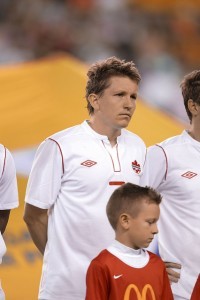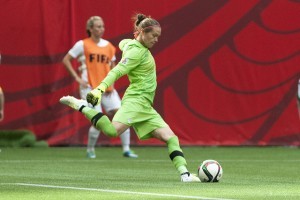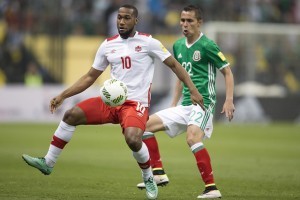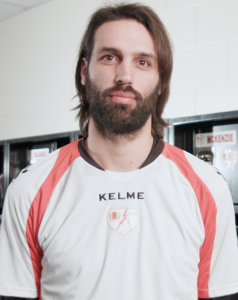Steven Sandor's Blog, page 76
April 6, 2016
Dunfield won’t join FC Edmonton after all: Moving on to a broadcasting career

Terry Dunfield
Terry Dunfield won’t be joining FC Edmonton after all.
After getting a trial with the NASL club in the preseason, the Canadian veteran was set to join the Eddies. Last week, FCE coach Colin Miller said that Dunfield’s signing was imminent.
But, things changed. Notably, Maple Leaf Sports and Entertainment made an offer that Dunfield couldn’t refuse.
Dunfield had been planning to juggle playing for FC Edmonton with a part-time job as a commentator for Toronto FC matches. But, MLSE upped its offer last week — and it no longer was possible for Dunfield to juggle two jobs. He had to choose one or the other, and broadcasting won out.
Here it is, in Miller’s words.
“I’d been speaking back-and-forth-between Terry and his agent for some time. And Terry was offered a job by MLSE to do the colour commentating for TFC, TFC2 and so forth. So, there was at one point, a situation where Terry would have missed six games in our season but been able to do both jobs. I was fully supportive of it because of the quality that Terry would have given us.
 “He was devastated that, at some point, his playing career was going to come to an end. But I said to him, ‘Terry, you’ve been offered a job that, for many, is a dream job. It would be one of my dream jobs, to be honest, to do some TV work. But you have to face reality that you’re 34 now and that, at some point, your playing career is going to come to an end.’
“He was devastated that, at some point, his playing career was going to come to an end. But I said to him, ‘Terry, you’ve been offered a job that, for many, is a dream job. It would be one of my dream jobs, to be honest, to do some TV work. But you have to face reality that you’re 34 now and that, at some point, your playing career is going to come to an end.’
“Long story short, MLSE moved the goalposts and offered him more money and more concrete an offer. So I spoke at length with him about it and I said ‘Terry you’d be very foolish to turn this down.’ This is job security in an industry that’s growing the TV industry.
“He wrote a fantastic e-mail thanking the club for the professionalism, the direction, the way the players were, the owners. It was very amicable. But, at some point Terry Dunfield has to think of himself and has to come to terms with the fact that his playing career has come to an end because of this offer has been given.”
Dunfield did colour commentary on one of the Canada Soccer streams in 2015, working with play-by-play man Gavin Day.
Erin McLeod’s injury will keep her out for at least a year

Erin McLeod
PHOTO: JAY SHAW/CANADA SOCCER
Canadian women’s national-team goalkeeper Erin McLeod had made the following statement regarding the status of her ACL injury.
To be frank, it’s pretty bad — about as bad as any Canadian fan would imagine. She won’t be available for the upcoming Olympics and, in terms of her recovery, we’re talking years, not months. And, as you’ll see in the statement, she says there are “no guarantees” that she makes a full recovery.
Here is her statement:
“Thank you to everyone for your sentiments and support. I want to apologize for not making a public statement until now about my injury, but I was waiting for all the information to make sure when I went public I was sure of what I wanted.
“First, I want to say how grateful I am to have the Canadian Soccer Association, the team, and staff, and of course medical staff behind me and supporting me every step of the way. I am also grateful for my current club, FC Rosengard, and all the support they have shown. It is clear to me that both parties are mostly interested in my health as a person first and foremost, and my life as a soccer player second.
“I tore my ACL in the Champions League semi-final game a few weeks ago. The biggest question is the Olympics and because I have already had two operations it makes a third one, well, extremely complicated. What I know for sure is I won’t be ready for August. My surgical options means it will take between one and two years to come back, and there are no guarantees, as there never really are in life.
“This news was of course heartbreaking because going to the Olympics is a dream as well as an honour. This Olympic team is one that will excite you, I know for me, it feels like I have been waiting for this group my whole career. The people on this team work harder than any other people I know, and, well, I know they will give anything for the emblem on their chests.
“As for me, family, friends, fans, thank you for your love, but know that I am grateful for every moment I have put on a Canadian jersey and this is not the end of the road for me – know that I’ve still got a lot of fight left and I hope to be on that field again someday soon.”
April 4, 2016
Overwhelmingly Canadian Power Rankings: MLS Week 5/NASL Week 1/USL Week 2

Fraser Aird
NASL kicked off its season this weekend, and it gives us a chance to see where Canadian appearances stand compared to last season at this time.
In 2015, when we finished Week 5 of the MLS season and Week 1 of the NASL season, 24 Canadians had seen the field for clubs in either of those leagues. A total of 11 clubs (four of them hailing from NASL) had given time to a Canadian.
Where do we stand this year? This year, at the same stage of the MLS and NASL seasons, 24 Canadians on 10 different teams have got minutes. So, if there is a difference between 2015 and 2016, it’s statistically insignificant.
If you notice any errors or omissions, especially on the USL side, please make a comment on what needs to be addressed.
Here are the rankings:
MLS AND NASL MINUTES BY PLAYER, THE CANADIANS
1. Fraser Aird, Vancouver, MLS, 405 (5)
2. Will Johnson, Toronto FC, MLS, 359 (4)
3. Cyle Larin, Orlando City, MLS, 259 (4)
4. Jonathan Osorio, Toronto FC, MLS, 241 (3)
5. Karl Ouimette, NYRB, MLS 225 (3)
6. Kianz Froese, Vancouver, MLS, 111 (2)
7. Kyle Bekker, Montreal, MLS, 100 (2)
8. Tesho Akindele, FC Dallas, MLS, 97 (4)
T9. Nana Attakora, Fort Lauderdale, NASL, 90 (1)
T9. Drew Beckie, Carolina, NASL, 90 (1)
T9. Marcel De Jong, Ottawa, NASL, 90 (1)
T9. Eddie Edward, FC Edmonton, NASL, 90 (1)
T9. Nik Ledgerwood, FC Edmonton, NASL, 90 (1)
T9. Kyle Porter, Ottawa, NASL, 90 (1)
15. Julian de Guzman, Ottawa, NASL, 76 (1)
16. Mo Babouli, Toronto FC, MLS 73 (2)
17. Anthony Jackson-Hamel, Montreal, MLS, 68 (4)
18. Mozzi Gyorio, Ottawa, NASL, 61 (1)
19. Mallan Roberts, FC Edmonton, NASL, 52 (1)
20. Ashtone Morgan, Toronto FC, MLS, 22 (3)
21. Sam Adekugbe, Vancouver, MLS, 21 (1)
22. Patrice Bernier, Montreal, MLS, 18 (1)
23. Allan Zebie, FC Edmonton, NASL, 10 (1)
24. Jay Chapman, Toronto FC 4 (1)
TEAM RANKINGS, MINUTES PLAYED BY CANADIANS IN 2016, RANKED BY AVERAGE MINUTES PER GAME:
Ottawa, NASL, 317 /1 (317)
FC Edmonton, NASL, 242/1 (242)
Toronto FC, MLS, 699/4 (174.8)
Vancouver, MLS, 537/5 (107.4)
Carolina, NASL, 90/1 (90)
Fort Lauderdale, NASL, 90/1 (90)
Orlando City, MLS, 259/4 (64.8)
New York Red Bulls, MLS, 225/4 (56.3)
Montreal, MLS, 186/4 (46.5)
FC Dallas, MLS, 97/5 (19.4)
 USL MINUTES BY PLAYER, THE CANADIANS
USL MINUTES BY PLAYER, THE CANADIANS
T1. Zachary Ellis-Hayden, Orlando City B, USL, 180 (2)
T1. John Smits, Wilmington, USL, 180 (2)
3. Mark Anthony Kaye, Louisville City FC, 169 (2)
4. Daniel Haber, WFC2, USL, 166 (2)
5. Brett Levis, WFC2, USL, 165 (2)
6. Thomas Gardner, WFC2, USL, 137 (2)
7. Jordan Haynes, WFC2, USL, 104 (2)
8. Chris Serban, WFC2, USL, 98 (2)
T9. Mo Babouli, TFC II, USL, 90 (1)
T9. Janouk Charbonneau, FC Montreal, USL, 90 (1)
T9. Kadin Chung, WFC2, USL, 90 (1)
T9. Raheem Edwards, TFC II, USL, 90 (1)
T9. Jackson Farmer, WFC2, USL, 90 (1)
T9. Jeremy Gagnon-Lapare, FC Montreal, USL, 90 (1)
T9. Wandrille Lefevre, FC Montreal, USL, 90 (1)
T9. Chris Mannella, TFC II, USL, 90 (1)
T9. Sean Melvin, WFC2, USL, 90 (1)
T9. Aron Mkungilwa, FC Montreal, USL, 90 (1)
T9. Anthony Osorio, TFC II, USL, 90 (1)
T9. David Paulmin, FC Montreal, USL, 90 (1)
T9. Michael Salazar, FC Montreal, USL, 90 (1)
T9. Dominic Samuel, Rochester, USL, 90 (1)
T9. Skylar Thomas, TFC II, USL, 90 (1)
24. Mitch Piraux, WFC2, USL, 86 (1)
25. Tyler Pasher, Swope Park Rangers, USL, 84 (1)
26. Aidan Daniels, TFC II, USL, 78 (1)
27 Louis Beland-Goyette, FC Montreal, USL, 77 (1)
28. Jordan Murrell, Pittsburgh, USL, 74 (1)
29. Mastanabal Kacher, FC Montreal, USL, 67 (1)
30. Matthew Baldisimo, WFC2, USL, 66 (2)
31. Giuliano Frano, WFC2, USL, 61 (2)
32. Richie Laryea, Orlando City B, USL, 58 (1)
33. Yacine Ait-Slimane, FC Montreal, USL, 34 (1)
34. Charles Joly, FC Montreal, USL, 23 (1)
35. Benjamin McKendry, WFC2, USL, 20 (1)
36. Heikel Jarras, FC Montreal, USL, 19 (1)
37. Mark Anthony Gonzalez, Swope Park Rangers, USL, 16 (2)
38. Fabrice Mbvouvouma, FC Montreal, USL, 13 (1)
39. Malik Johnson, TFC II, USL, 12 (1)
40. Terren Campbell, WFC2, USL, 10 (2)
41. Amer Didic, Swope Park Rangers, USL, 3 (1)
42. Adam Bouchard, TFC II, USL,1 (1)
USL TEAM RANKINGS, MINUTES PLAYED BY CANADIANS IN 2016, RANKED BY AVERAGE MINUTES PER GAME:
FC Montreal, 773/1 (773)
WFC2, 1173/2 (586.5)
TFC II, 541/1 (541)
Orlando City B, 238/2 (119)
Wilmington Hammerheads FC, 180/2 (90)
Rochester Rhinos, 90/1 (90)
Louisville City FC, 169/2 (84.5)
Pittsburgh Riverhounds, 74/1 (74)
Swope Park Rangers, 113/2 (56.5)
April 3, 2016
Red-card happy MLS referees: It’s a case of ‘Be careful what you wish for…’
 On Saturday night, both the Vancouver Whitecaps and Toronto FC had players sent off. As is the case with most of the times a ref brandishes the red card, there were many howls of protest. And, we’re seeing more and more fans question why MLS refs are punishing infractions more severely than they have in the past.
On Saturday night, both the Vancouver Whitecaps and Toronto FC had players sent off. As is the case with most of the times a ref brandishes the red card, there were many howls of protest. And, we’re seeing more and more fans question why MLS refs are punishing infractions more severely than they have in the past.
Many will argue that Matias Laba’s sending-off on Saturday night wasn’t warranted, that he was making a legitimate slide tackle on the ball. Toronto FC fans will argue that Benoit Cheyrou’s, ahem, “elbow” didn’t warrant his second yellow of the evening.
The growing theme amongst MLS supporters is not what the refs are missing, but what they’re calling. Phantom fouls that result in penalties, red cards for harsh but not-that-dirty tackles.
Damn straight that refs are calling the games more closely and more harshly than ever before. And guess what? It’s because fans and the league asked them to do it that way, that’s why. Before griping about the calls we’re seeing, remember this…
BE CAREFUL WHAT YOU WISH FOR.
Let’s all head to S.T.A.R. Labs and “zoom” back to 2011. Back then, MLS had a nasty international reputation as being a dirty league, a place where fouls often went unpunished and player safety was not cared about. When I covered the league for the Sun back in the early TFC years, I’d lost count of the number of times players and league officials spoke out about “serious foul play.” That’s in quotes because it was a term I heard all the time. There were worries that the league’s rep for lawlessness kept international players away, and that it prevented MLS from attracting fans of other leagues.
Remember that, at that time, maybe the most replayed incident in an MLS game was not a goal or a great save, but Houston’s Ricardo Clark kicking FC Dallas’s Carlos Ruiz when Ruiz was on the ground.
In 2010, then-MLS discipline domo Nelson Rodriguez had to issue an edict to all the teams in the league at the time about a series of violent incidents that marred the preseason, including dirty tackles that targeted star players such as New York’s Juan Pablo Angel. ““Certainly we do not want MLS to be characterized by frequent violent conduct or serious foul play,” he said at the time.
 Peter Nowak, the Philadelphia Union’s coach at the time, said “at some of these games, it’s like a freak show and a circus.”
Peter Nowak, the Philadelphia Union’s coach at the time, said “at some of these games, it’s like a freak show and a circus.”
In 2011, Real Salt Lake and Sporting Kansas City confronted each on the on the field in a preseason game.
So, in 2011, PRO referees — the organizations which oversees officiating in North American pro soccer — was launched. But with it came an edict from MLS. Crack down on fouls. Before the 2011 season, commissioner Don Garber said “the man on ball will be protected a lot more than in the past.” That meant that referees were instructed to err on the side of the attacking player. (CLICK HERE FOR MORE)
But, in 2011, the rash challenges continued. In arguably the most high-profile play of the season, Seattle’s Steve Zakuani had his leg shattered. Real Salt Lake star Javier Morales fell victim to a brutal tackle. And, while it wasn’t a dirty play, FC Dallas’s David Ferreira — regarded as the league’s best player at the time — suffered a serious injury as a result of a challenge from Vancouver’s Jonathan Leathers.
Now, remember how we all bayed for the head of Brian Mullan, the player whose tackle basically ended Zakuani’s career? Remember how we all said that MLS has to do better to protect its players?
So, in 2012 Garber was back at it; he promised that the league would do more to protect its star players. He admitted the league had a problem with dirty play.
(CLICK HERE FOR MORE)
And so we began the pattern which we see continued today. MLS does not want to go back to the days where it’s seen as a cowboy-rules circuit. It does not want to go back to the days of “yet another leg-breaking tackle.” Refs have been instructed to call the game close. It’s been five years since MLS launched its crackdown, but you have to remember that the referees who call MLS, NASL and USL games are coming up through the PRO culture; referees who don’t let a lot go lead to more referees who don’t let a lot go.
And, in 2016 (thank to Michael Crampton for pointing this out), Peter Walton, the head of PRO Referees, was quoted on MLS’s own website, speaking about how there still were NOT enough red cards being shown to players. He said that PRO’s research found that 28 per cent of red-card offences in MLS games were missed. So, there’s even more pressure than before on refs to show red in 2016. (CLICK HERE TO SEE IT)
So you wonder how we got here? Really? Five years ago, we were all asking MLS to get tough on offenders.
And if you think replay will change some of these calls, ask yourself: How many of these cards is the Disciplinary Committee overturning? (Crickets). How many suspensions are we seeing for unpunished-at-the-time incidents that the DisCo felt were red-card offences? (Wide show of hands).
Before thinking that giving refs more tools to second-guess themselves will change the game, we have to ask themselves if, under the call-everything culture, that they’d actually second-guess themselves.
April 2, 2016
Miller proud of FCE’s defensive doggedness

Rayo OKC’s Sebastian Velasquez attempts a shot as FCE’s Cristian Raudales and Eddie Edward move in. PHOTO: NASL
It wasn’t pretty. But, considering the circumstances, it was effective.
After captain Albert Watson was sent off in the first half, FC Edmonton was forced to hunker and bunker in its NASL season opener at Rayo OKC. But a valiant double-save from FCE keeper Matt VanOekel and some dogged defending from the Eddies allowed the visitors to escape with a 0-0 draw.
“I am very proud of them tonight,” said coach Colin Miller. “The way we defended tonight, it’s there for everyone to see. It was a real test of character for our team. It’s a new opponent, a team that has a lot of very experienced players. And I’m disappointed that we went down to 10 men. It changes our substitution plan. It changes our whole outlook on the game.”
Rayo OKC had two golden chances to win the game in the 78th minute; veteran striker and Celtic great Georgios Samaras got into the box and spanked a low drive at goal. VanOekel came out, took away the angle, and made the save. But the ball went out to Rayo’s Richie Menjivar at the top of the box, but VanOekel moved smartly across the box and sprawled to make the second stop.
Rayo had a decent chance earlier in the second half which, ironically, came off an errant pass from VanOekel. His pass from the box went right to Rayo striker Robbie Findley. But the former Toronto FC man sent his shot wide of an open goal.
Watson saw straight red in the first half after he gave the ball away to Rayo OKC’s Marvin Chavez. Watson got caught with an arm and leg out, Chavez went down, and referee Nima Saghafi pulled out the red.
While Miller suggested that Chavez may have been looking for the foul, he didn’t protest the call itself. In fact, he said that Saghafi had a good game and was consistent through the 90 minutes.
 “It (the red-card incident) was difficult for me to see, it was at the other end of the pitch,” said Miller. “But there are some players at this level who are going to go down like that. But, it was a very bad first touch from Albert. That touch takes him right into the player.”
“It (the red-card incident) was difficult for me to see, it was at the other end of the pitch,” said Miller. “But there are some players at this level who are going to go down like that. But, it was a very bad first touch from Albert. That touch takes him right into the player.”
Pape Diakite was arguably the best Eddie outside of VanOekel. The central defender bravely broke up attack after attack. Colin Miller said that Nik Ledgerwood’s work in the middle of the park was “immense;” and, remember that Ledgerwood was coming off a full 90 at Azteca Stadium in the middle of the week. And, after coming in to fortify the defence, Canadian Mallan Roberts acquitted himself well. For Roberts, it was a big moment, because he’d lost his starting place.
“Mallan hadn’t been well, and with his attitude of late, he wasn’t in the team,” Miller said.
With Watson suspended for next week’s home opener against Minnesota, the safe bet is that we’ll see the Roberts-Diakite central-defence partnership get another go.
But, despite a lack of offensive chances, a point on the road is a decent return for the Eddies. Remember that, last season, they opened the NASL campaign at Jacksonville — the new expansion team — and conceded within 12 seconds on their way to a loss. So, this 0-0 in OKC is a Picasso compared to last year’s opener versus an expansion side.
“If we can defend like that, and we can keep 11 players on the park and can create some chances, then things will look up for the Eddies,” said Miller.
March 30, 2016
Making sense of it all: What the new NASL TV deals mean for Canadian viewers
 NASL announced a new international TV deal with beIN Sports and an American webcasting deal with ESPN3 on Wednesday. On top of that, the New York Cosmos has its own TV deal with One World Sports.
NASL announced a new international TV deal with beIN Sports and an American webcasting deal with ESPN3 on Wednesday. On top of that, the New York Cosmos has its own TV deal with One World Sports.
Of course, the announcements that the league makes are aimed at American audiences — and they often leave Canadian fans feeling confused. After all, Canadians can’t access ESPN3; and the fears set in that 2016 could be like 2015, when a lot of NASL games that were slated to appear on TSN GO never made it to our computers.
Well, The 11 is here to make sense of the deals.
NASL will have three national broadcasters in the U.S.; that’s ESPN3, OneWorld Sports and beIN Sports.
Here’s what the league says: “On a national level, E3 games will only be on E3, OWS games will only be on OWS, and beIN games will only be on beIN. None of those affect local broadcasts, so no blackouts. All E3 games will be available on NASL.com to Canadian viewers only. OWS will be open to all in North America via their website, and beIN will be open to all in North America as well.” OneWorld Sports has the Cosmos games; beIN will have select weekend and midweek matches. OneWorld will make its stream available for Canadian viewers when the Eddies and the Fury visit New York. The beIN packages, both on cable and on web, are available in Canada. So, if you’re a subscriber, you’ll be able to access those games.
OneWorld Sports has the Cosmos games; beIN will have select weekend and midweek matches. OneWorld will make its stream available for Canadian viewers when the Eddies and the Fury visit New York. The beIN packages, both on cable and on web, are available in Canada. So, if you’re a subscriber, you’ll be able to access those games.
Yes, beIN costs money. On Shaw, it’s $14.99 a month: About the same as two beers. It costs money to put games on TV. If you don’t think it’s OK to pay for your content, then you won’t mind me coming to your house and crashing there whenever I want and eating whatever you’ve got in the refrigerator. (Of course there’s a bias there; I’m in the soccer-broadcasting business. Consider that my disclaimer.) Sorry, but I want to pre-empt the “but I have to pay for it” whining now.
The rest of the games will be broadcast on ESPN3 in the United States. Canadian viewers will be able to access those on NASL.com.
Feel better? We all will after we see how the first week of games go. After all, most of us remember not being able to find the games at the start of last season.
March 29, 2016
After two losses to Mexico, Canada is still in decent shape

Canada’s Junior Hoilett is seen in action against Mexico. PHOTO: MEXSPORT/CANADA SOCCER
When the CONCACAF World Cup qualifying groups were revealed, we all agreed that Canada’s mission was simple; to qualify for the Hex, the men’s national team didn’t have to finish ahead of Mexico — that would be unrealistic. It only needed to be better than Honduras and El Salvador.
Canadian national-team coach Benito Floro, said the same thing — that Mexico would be off in its own world, and it was basically a three-team race for second place.
So, after Tuesday’s 2-0 loss to Mexico at Azteca, Canada now has four points from four of six games played. That’s the same point total as Honduras, and two up on El Salvador. Honduras holds a massive advantage in goal difference.
But this is all that matters: With games left against El Salvador (home) and Honduras (away), Canada still controls its own destiny. At the start of this group stage, we would have taken this scenario. Gladly. Two games left, and all to play for — with no games left against Mexico.
Honduras and El Salvador each have one game each left against the Mexicans. Worried that the Mexicans, who have already wrapped up top spot in Group A, will take it easy for those matches? Remember this: Mexico’s rivalries with their Central American neighbours are super-heated. They hate El Salvador. They hate Honduras. And nothing would give the Mexicans more pleasure than to finish the group a perfect 6-0-0 and end Honduras’s and El Salvador’s World Cup dreams in the process.
So, put the two losses to Mexico out of your mind. Canada is still where it needs to be. If the Canadians don’t make it to the Hex, it was because they didn’t take care of what they needed to do in the final two games. Forget about the 8-1 last time they were in Honduras. They need results and, if they get them, they won’t need to scoreboard watch. No more excuses.
Actually, if Mexico does indeed to continue to flex its muscles, there’s a chance that Canada could eke out draws in its final two games and still reach the Hex.
At both BC Place and Azteca, Mexico proved that their skill level is far beyond Canada’s reach. But we knew this, didn’t we? Heck, at Azteca, Mexican coach Juan Carlos Osorio didn’t give starts to either Hirving Lozano and Javier Hernandez, who each scored in Friday’s 3-0 win in Vancouver. He has so many weapons at his disposal, he could afford to rotate the squad.
Canadian national-team coach Benito Floro brought in Nik Ledgerwood to replace Tosaint Ricketts on the right side, while Manjrekar James came in for Adam Straith at centre back. James ended up arguably being Canada’s best player on the night, a steadying influence in the back. Canada’s shape was better in Azteca than it was in BC Place.
But, at Azteca, having discipline and decent shape simply isn’t enough. There’s a massive talent gap to bridge. Yet, if Canada plays in Honduras like it did in Mexico, a 0-0 isn’t out of the question.
 Marco Fabian, though he didn’t score, was the man who brought misery to Canada. In the 16th minute, he got goal side of Canadian right back Doneil Henry, felt a nudge, and went down to the ground — drawing a penalty that Andres Guardado converted. Now, before any debate about soft CONCACAF penalties is begun, it has to be noted that Fabian only went down after he put the ball into the middle of the Canadian penalty area. The ball went into the net on the next touch. So, had the penalty not been awarded, Mexico’s goal out of open play would have stood. No matter which way you look at it, 1-0 to Mexico was a fair outcome.
Marco Fabian, though he didn’t score, was the man who brought misery to Canada. In the 16th minute, he got goal side of Canadian right back Doneil Henry, felt a nudge, and went down to the ground — drawing a penalty that Andres Guardado converted. Now, before any debate about soft CONCACAF penalties is begun, it has to be noted that Fabian only went down after he put the ball into the middle of the Canadian penalty area. The ball went into the net on the next touch. So, had the penalty not been awarded, Mexico’s goal out of open play would have stood. No matter which way you look at it, 1-0 to Mexico was a fair outcome.
Later in the first half, Fabian blistered a shot at keeper Milan Borjan’s hands. After making the stop, Borjan kicked the ball into touch and immediately signalled to the bench that he needed to come off. His hand was injured on the play, and he couldn’t put his keeper glove back on.
Before the first half ended, sub keeper Kenny Stamatopoulos had to fetch the ball out of the back his net. Jesus Corona scored an absolute peach of a goal; it started with a spin move at the top of the box that befuddled veteran Canadian midfielder Atiba Hutchinson, and finished with a perfect shot into the bottom corner of the goal.
Mexico took the foot off the gas in what was an uneventful second half. And that’s what should give Canadians hope. In two second halves this week, Mexico showed Canada the quality of mercy. And this might give us an indication that they might want to give us a hand when it comes to getting rid of Honduras and El Salvador.
I mean, you’ve got to look for every positive you can, right?
FCE coach Miller predicts a rough reception for Rayo OKC’s Samaras

Georgios Samaras
In the blue corner is FC Edmonton coach Colin Miller, who spent three years at Scottish giants Rangers, and who still has a strong connection to the famous club.
In the green corner is Georgios Samaras, who scored 53 career Scottish Premier League goals for Celtic.
Samaras recently signed with NASL expansion side Rayo OKC, which will play its first-ever regular-season home opener Saturday. The Eddies will be in Oklahoma. The Eddies are the league’s team of choice when it comes to being the opposition for the expansion teams making their debuts. Remember that Jacksonville scored just 12 seconds into its NASL opener against the Eddies in 2015.
Samaras will be wearing OKC colours, but Miller still remembers his exploits in the green and white hoops. And green and white, to Miller, is like waving a red flag in front of a bull.
“I can assure you, (captain and centre back) Albert Watson won’t need any motivation, either,” said Miller. “I actually just spoke about it (with the team). Samaras has had a terrific career but, he doesn’t necessarily like the rough stuff. So, we’ll introduce ourselves to him on Saturday.”
FCE will have Shamit Shome, who was with the Canadian U-20 squad that beat England, on the trip to Oklahoma City. Nik Ledgerwood, on national-team duty with Canada, and Dustin Corea, who is with El Salvador’s national side, will join the Eddies in Oklahoma.
The Eddies will also be moving to a 4-4-2 formation. That might change when the subs come in — depending on the score. But, at kickoff, then Eddies will move away from the lone-target-man setup that they’ve used heavily the past couple of seasons.
”We’ve played 4-2-3-1 and 4-1-4-1 over the last couple of seasons,” said Miller. “And, you see the game changing now — things, trends, fashions. But I want to see two players further forward for us. Whover that is, if it’s (Daryl) Fordyce and (Tomi) Ameobi or (Jake) Keegan, it doesn’t matter at this point in time, I’d like to see someone else other than one target front player. I want to see support get up to him much quicker.
 “I’m asking a lot of the midfield four and the front two from a defensive point of view, but our fitness levels will hopefully determine that.”
“I’m asking a lot of the midfield four and the front two from a defensive point of view, but our fitness levels will hopefully determine that.”
And, Miller said that if the best Cinderella story in the world of soccer has built itself on the 4-4-2, it’s good enough for the Eddies.
“The best example we can use of 4-4-2 at the moment is Leicester City. And if it’s good enough for a club that’s at that budget to play against clubs that spend upwards of 300 million pounds on their teams, and to be top of the English Premier League, I don’t think anyone can argue with that.”
FC Edmonton coach Colin Miller confirms that Terry Dunfield’s signing is imminent

Terry Dunfield
Terry Dunfield’s soccer journey will take him to Edmonton.
The veteran Canadian midfielder’s trial with the Eddies has been successful — coach Colin Miller confirmed that Dunfield will sign with the club. Dunfield trained with the Eddies at Clarke Field Tuesday after arriving in the city Monday night. He joined the team on trial while the Eddies were on their Scottish tour, and played in games against Newcastle United’s youth team and Queen’s Park.
“Terry is going to sign with us,” said FCE coach Colin Miller. “I’m delighted with that. He still has to be approved by the league and so on and so forth, but I’ve worked with Terry both at the Whitecaps and with the national team, and I know all about him. I know his history, I know the qualities that he brings to the club. He’s a leader, he’s an experienced professional player and he’s top levels of the game for a number of years. He will add a great deal to the group.”
Miller compared Dunfield to Nik Ledgerwood, another Canadian national-team veteran who signed with the Eddies in the off-season.
“Hes a Nik Ledgerwood type. He’d kick his granny to win, same as Leg does. I’m not saying Leg would kick his granny, but he probably would in order to win, knowing him. That’s the type of people we want here now, we want winners.”
 Dunfield chose not to speak to the media today, as he just got into Edmonton and wants to take a day or two to get acclimated to his new club and city.
Dunfield chose not to speak to the media today, as he just got into Edmonton and wants to take a day or two to get acclimated to his new club and city.
Dunfield has made 14 appearances for the Canadian senior national team. He turned 34 in February. He came up through the Manchester City and played at various clubs in England before moving back home in 2010 to play for the Whitecaps. He was later traded to Toronto FC, where he was named the Reds’ player of the year in 2012. But injury problems led to his release in 2013, and he’s since played in England for Oldham Athletic and in Scotland for Ross County.
March 27, 2016
Overwhelmingly Canadian Power Rankings, MLS Week 4/USL Week 1

Fraser Aird
With this being an international weekend, there was only a limited schedule of games in MLS.
Yet, this week, we’ll announce a change in the way we do things with our power rankings. We will track the minutes played by Canadians in USL. But, to make sure fair is fair, the USL numbers are not tracked on the same list as MLS and NASL. Why? Because, in USL, Canadian are treated as domestics league wide. In MLS and NASL, only Canadians who play on Canadian clubs are treated as domestics; Canadians on American clubs are treated as internationals unless they have dual citizenships or green cards.
Of course, Americans in all three leagues are domestics on all Canadian and U.S. teams.
Because USL doesn’t carry the double standard when it comes to Canadians, it’s impossible to rate it along with NASL and MLS. As well, because of send-downs and call-ups, there will be some players who accrue MLS minutes and also get time playing with the MLS-parent-club affiliated USL teams.
And, the Canadian Soccer Association has mandated guidelines for the three Canadian USL teams when it comes to having our players on their rosters and on the field. That’s another reason why USL needs to be ranked separately.
Here are the rankings:
MLS AND NASL MINUTES BY PLAYER, THE CANADIANS
1. Fraser Aird, Vancouver, MLS, 315 (4)
2. Will Johnson, Toronto FC, MLS, 269 (3)
3. Cyle Larin, Orlando City, MLS, 235 (3)
4. Jonathan Osorio, Toronto FC, MLS, 178 (2)
5. Karl Ouimette, NYRB, MLS 135 (2)
6. Kianz Froese, Vancouver, MLS, 111 (2)
7. Tesho Akindele, FC Dallas, MLS, 52 (3)
8. Anthony Jackson-Hamel, Montreal, MLS, 47 (3)
9. Sam Adekugbe, Vancouver, MLS, 21 (1)
10. Mo Babouli, Toronto FC, MLS 13 (1)
12. Kyle Bekker, Montreal, MLS, 10 (1)
12. Ashtone Morgan, Toronto FC, MLS, 8, (2)
13. Jay Chapman, Toronto FC 4 (1)
TEAM RANKINGS, MINUTES PLAYED BY CANADIANS IN 2016, RANKED BY AVERAGE MINUTES PER GAME:
Toronto FC, MLS, 472/3 (157.3)
Vancouver, MLS, 447/4 (111.8)
Orlando City, MLS, 235/3 (78.3)
New York Red Bulls, MLS, 135/3 (45)
Montreal, MLS, 57/3 (19)
FC Dallas, MLS, 52/4 (13)
USL MINUTES BY PLAYER, THE CANADIANS
T1. Mo Babouli, TFC II, USL, 90
T1. Janouk Charbonneau, FC Montreal, USL, 90
T1. Raheem Edwards, TFC II, USL, 90
T1. Zachary Ellis-Hayden, Orlando City B, USL, 90
T1. Jackson Farmer, WFC2, USL, 90
T1. Jeremy Gagnon-Lapare, FC Montreal, USL, 90
T1. Daniel Haber, WFC2, USL, 90
T1. Jordan Haynes, WFC2, USL, 90
T1. Mark Anthony Kaye, Louisville City FC, 90
T1. Wandrille Lefevre, FC Montreal, USL, 90
T1. Chris Mannella, TFC II, USL, 90
T1. Sean Melvin, WFC2, USL, 90
T1. Aron Mkungilwa, FC Montreal, USL, 90
T1. Anthony Osorio, TFC II, USL, 90
T1. David Paulmin, FC Montreal, USL, 90
T1. Michael Salazar, FC Montreal, USL, 90
T1. Chris Serban, WFC2, USL, 90
T1. John Smits, Wilmington, USL, 90
T1. Skylar Thomas, TFC II, USL, 90
20. Mitch Piraux, WFC2, USL, 86
21. Brett Levis, WFC2, USL, 83
22. Aidan Daniels, TFC II, USL, 78
23. Louis Beland-Goyette, FC Montreal, USL, 77
T24. Thomas Gardner, WFC2, USL, 67
T24. Mastanabal Kacher, FC Montreal, USL, 67
26. Yacine Ait-Slimane, FC Montreal, USL, 34
27. Giuliano Frano, WFC2, USL, 33
28. Charles Joly, FC Montreal, USL, 23
29. Heikel Jarras, FC Montreal, USL, 19
30. Fabrice Mbvouvouma, FC Montreal, USL, 13
31. Malik Johnson, TFC II, USL, 12
32. Terran Campbell, WFC2, USL, 7
33. Matthew Baldisimo, WFC2, USL, 4
T34. Adam Bouchard, TFC II, USL,1
T34. Mark Anthony Gonzalez, Swope Park Rangers, USL, 1
USL TEAM RANKINGS, MINUTES PLAYED BY CANADIANS IN 2016, RANKED BY AVERAGE MINUTES PER GAME:
FC Montreal, 773/1
WFC2, 720/1
TFC II, 541/1
Louisville City FC, 90/1
Orlando City B, 90/1
Wilmington Hammerheads FC, 90/1
Swope Park Rangers, 1/1




